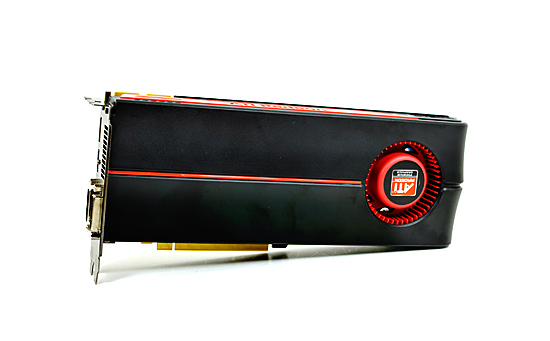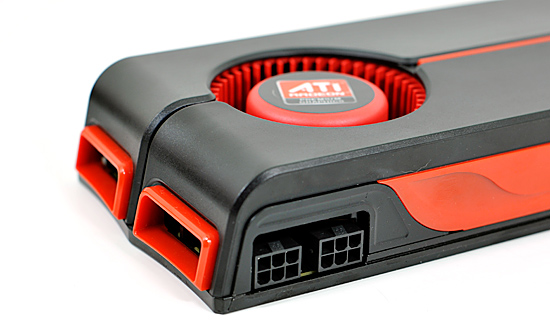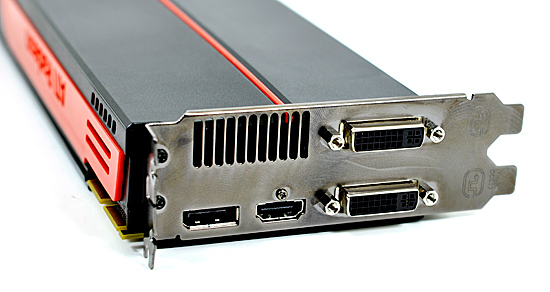AMD's Radeon HD 5870: Bringing About the Next Generation Of GPUs
by Ryan Smith on September 23, 2009 9:00 AM EST- Posted in
- GPUs
Meet the 5870
The card we’re looking at today is the Radeon HD 5870, based on the Cypress core.

Compared to the Radeon HD 4870, the 5870 has seen some changes to the board design. AMD has now moved to using a full sheath on their cards (including a backplate), very much like the ones that NVIDIA has been using since the 9800GTX. The card measures 10.5” long, an inch longer than the 4890 or the same as the 4870x2 and the NVIDIA GTX lineup.
The change in length means that AMD has moved the PCIe power connectors to the top of the card facing upwards, as there’s no longer enough room in the rear. Facing upwards is also a change from the 4870x2, which had them facing the front of the card. This, in our opinion, makes it easier to plug and unplug the PCIe power connectors, since it’s now possible to see what you’re doing.
Since the card has a TDP of 188W, AMD can still get away with using two 6-pin connectors. This is going to be good news for those of you with older power supplies that don’t feature 8-pin connectors, as previously the fastest cards without 8-pin connectors were the 4890 and GTX 285.

Briefly, the 5850 that we are not testing today will be slightly smaller than the 5870, coming in at 9.5”. It keeps the same cooler design, however the PCIe power connectors are back on the rear of the card.
With the 5800 series, DisplayPort is getting a much-needed kick in the pants. DisplayPort (full size) is standard on all 5800 series cards – prior to this it has been rather absent on reference cards. Along with a DisplayPort, the 5870 reference card contains a dedicated HDMI port, and a pair of DVI ports.
Making 4 ports fit on a card isn’t a trivial task, and AMD has taken an interesting direction in making it happen. Rather than putting every port on the same slot of the bracket as the card itself, one of the DVI ports is raised on to the other bracket. ATI could have just as easily only equipped these cards with 1 DVI port, and used an HDMI-to-DVI adapter for the second port. The advantage of going this direction is that the 5800 series can still drive two VGA monitors when using DVI-to-VGA adapters, and at the same time having an HDMI port built in means that no special adapters are necessary to get an HDMI port with audio capabilities. The only catch to this specific port layout is that the card still only has enough TMDS transmitters for two ports. So you can use 2x DVI or 1x DVI + HDMI, but not 2x DVI + HDMI. For 3 DVI-derived ports, you will need an active DisplayPort-to-DVI adapter.
With the configuration AMD is using, fitting that second DVI port also means that the exhaust vent of the 5800 series cards is not the full length of the card as is usually common, rather it’s a hair over half the length. The smaller size had us concerned about the 5870’s cooling capabilities, but as you’ll see with our temperature data, even with the smaller exhaust vent the load temperatures are no different than the 4870 or 4850, at 89C. And this is in spite of the fact that the 5870 is rated 28W more than the 4870.

With all of these changes also comes some changes to the loudness of the 5870 as compared to the 4870. The 27W idle power load means that AMD can reduce the speed of the fan some, and they say that the fan they’re using now is less noticeable (but not necessarily quieter) than what was on the 4870. In our objective testing the 5870 was no quieter than any of the 4800 series cards when it comes to idling at 46.6dB, and indeed it’s louder than any of those cards at 64dB at load. But in our subjective testing it has less of a whine. If you go by the objective data, this is a push at idle and louder at load.
Speaking of whining, we’re glad to report that the samples we received do not have the characteristic VRM whine/singing that has plagued many last-generation video cards. Most of our GTX cards and roughly half of our 4800 series cards generated this noise under certain circumstances, but the 5870 does not.
Finally, let’s talk about memory. Despite of doubling just about everything compared to RV770, Cypress and the 5800 series cards did not double their memory bandwidth. Moving from the 4870 and it’s 900MHz base memory clock, the 5870 only jumps up by 33% to 1.2Ghz, in effect increasing the ratio of GPU compute elements to memory bandwidth.
When looking back at the RV770, AMD believes that they were not bandwidth starved on the cards that used GDDR5. And since they had more bandwidth than they needed, it was not necessary to go for significantly more bandwidth for Cypress. This isn’t something we can easily test, but in our benchmarks the 5870 never doubles the performance of the 4870, in spite of being nearly twice the card. Graphics processing is embarrassingly parallel, but that doesn’t mean it perfectly scales. The different may be a product of that or a product of the lack of scaling in memory bandwidth, we can’t tell. What’s for certain however is that we don’t have any hard-capped memory bandwidth limited situations, the 5870 always outscores the 4870 by a great deal more than 33%.










327 Comments
View All Comments
erple2 - Wednesday, September 23, 2009 - link
I think that you're missing the point. AMD appeared to want the part to be small enough to maximize the number of gpu's generated per wafer. They had their own internal idea of how to get a good yield from the 40nm wafers.It appears to be similar to their line of thinking with the 4870 launch (see http://www.anandtech.com/video/showdoc.aspx?i=3469">http://www.anandtech.com/video/showdoc.aspx?i=3469 for more information) - they didn't feel like they needed to get the biggest, fastest, most power hungry part to compete well. It turns out that with the 5870, they have that, at least until we see what Nvidia comes out with the G300.
It turns out that performance really isn't all people care about - otherwise nobody would run anything other than dual GTX285's in SLI. People care about performance __at a particular price point__. ATI is trying to grab that particular sweet spot - be able to take the performance crown for a particular price range. They would probably be able to make a gargantuan low-yield, high power monster that would decimate everything currently available (crossfire/SLI or single), but that chip would be massively expensive to produce, and surprisingly, be a poor Return on Investment.
So the comment that Cypress is "too big" I think really is apropos. I think that AMD would have been able to launch the 5870 at the $299 price point of the 4870 only if the die had been significantly smaller (around the same size as the 4870). THAT would have been an amazing bang-for-buck card, I believe.
Doormat - Wednesday, September 23, 2009 - link
[Big Chart] and suchfaxon - Wednesday, September 23, 2009 - link
page 15 is missing its charts guys! look at it, how did that happen lmaoGary Key - Wednesday, September 23, 2009 - link
Ryan is updating the page now. He should be finished up shortly. We had a lot of images that needed to be displayed in a different manner at the last minute.Totally - Wednesday, September 23, 2009 - link
the images are missingdguy6789 - Wednesday, September 23, 2009 - link
You very clearly fail to mention that the cheapest GTX295 one can buy is nearly $100 more expensive than the HD 5870.Ryan Smith - Wednesday, September 23, 2009 - link
In my own defense, when I wrote that paragraph Newegg's cheapest brand-new GTX 295 was only $409. They've been playing price games...SiliconDoc - Friday, September 25, 2009 - link
That "price game" is because the 5870 is rather DISAPPOINTING when compared to the GTX295.I guess that means ATI "blew the competition" this time, huh, and NVidia is going to get more money for their better GTX295.
LOL
That's a *scowl* "new egg price game" for red fans.
Thanks ATI for making NVidia more money !
strikeback03 - Wednesday, September 23, 2009 - link
lol, did they drop the price while they had 5870s in stock, then raise it again once they were gone?SiliconDoc - Wednesday, September 23, 2009 - link
Oh, so sorry, 1:46pm, NO 5870's available at the egg...I guess they sold 1 powercolor and one asus...
http://www.newegg.com/Product/ProductList.aspx?Sub...">http://www.newegg.com/Product/ProductLi...1&na...
---
Come on anandtech workers, you can say it "PAPER LUANCH !"